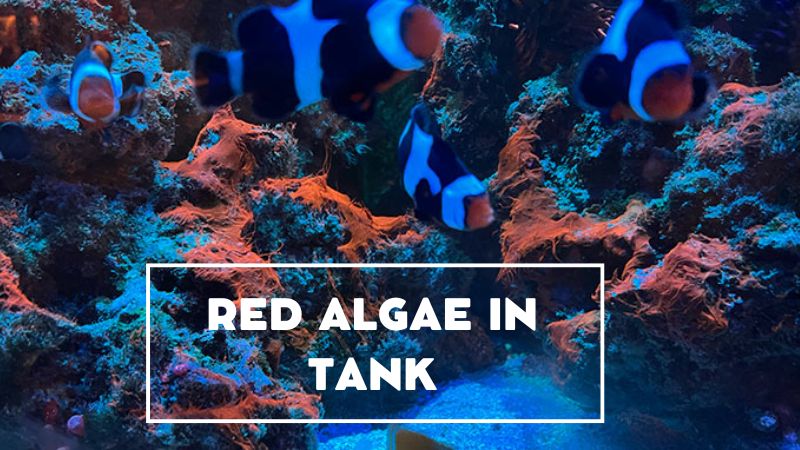The vibrant underwater world of your aquarium can be disrupted by the unwelcome appearance of red algae. This unwelcome guest, often referred to as “red slime algae” or cyanoobacteria, isn’t a true algae but a type of bacteria. While a small amount might exist unnoticed, excessive red algae growth can become unsightly and harm the health of your fish and plants. Understanding the causes and effective eradication methods is crucial to restoring the balance in your tank. Let’s join Tropical Fish Haven to learn more about red algae in tanks.
What is red algae in tank?
Red algae in a tank, also known as red slime algae or cyanobacteria, is a type of photosynthetic bacteria rather than true algae. It appears as a slimy, reddish or purplish film that can quickly spread over surfaces in aquariums. Red algae thrive in environments with excess nutrients (like phosphates and nitrates), low water flow, and poor water quality. It can be a nuisance in aquariums, affecting water clarity and potentially harming plants and fish if not controlled. Managing nutrient levels, improving water circulation, and performing regular water changes are essential steps to prevent and combat red algae outbreaks in aquariums.
What causes red algae outbreaks?
Red algae appear when the aquarium is 0-6 months old. When the tank is just being set up, red algae seems to have the most conditions to appear and develop.
To grow red algae, they need: light for photosynthesis, necessary nutrients to help their structure grow, red algae tend to appear in places with low flow.
How To Remove Red Slime Algae
Red Slime Algae, Also Known as Cyanobacteria
Cyanobacteria, commonly referred to as “red slime” algae, is actually a type of bacteria rather than marine algae. Despite the name “cyanobacteria” originating from its blue-green color, there are various colors of cyanobacteria, with the red type being of particular concern to aquarists. Red slime algae initially appears in small patches and can quickly spread to cover large areas.
To thrive, red slime algae requires light and nutrients.
Lighting
Using aquarium lights with a Kelvin rating below 10,000K can promote the growth of red slime algae in your aquarium. This is typically less of an issue for aquarists who use lights in the blue spectrum. The PAR rating of your aquarium lights is also crucial, especially with the powerful new marine aquarium LED lights available today. Another factor to consider is the duration of time the aquarium lights are on. If the aquarium is illuminated for 10 to 12 hours daily, reducing this to 8 hours may help control the growth of red slime algae.
Nutrients
The presence of Dissolved Organic Compounds (DOCs) is the primary factor contributing to red slime algae in marine aquariums. Phosphates (PO4) and nitrates (NO3) are particularly important nutrients to monitor and manage to combat red slime algae. By reducing phosphates and nitrates in your marine aquarium, you can effectively starve the cyanobacteria.
Phosphates (PO4) often enter aquariums through various sources, and addressing these sources is key to reducing DOCs. Potential sources include unfiltered tap water, inadequate reverse osmosis (R/O) systems, or worn-out filters in the R/O unit. It’s crucial to use a TDS meter (Total Dissolved Solids) to check your R/O system for any issues. Any identified problems should be promptly corrected before proceeding with aquarium maintenance.
Many aquarium products contain some phosphate, but a significant source of phosphates in the aquarium is the fish food. Cutting back on feeding can help reduce phosphate levels. Alternatively, employing a robust clean-up crew to consume excess food can also assist in managing phosphates. If reducing feeding is not feasible and water quality remains good, consider reducing the aquarium’s bioload or exploring other methods to eliminate phosphates. Using a phosphate reactor can effectively lower phosphates, but it’s crucial to address nitrates as well. Lowering nitrates is essential for completely eliminating red slime algae.
Bio Beads are highly effective in reducing nitrates and may suffice to combat red slime algae. Another effective method, although less commonly used nowadays, is a sulfur denitrator, which also effectively reduces nitrates.
Nitrates are the final byproduct of the nitrogen cycling process in aquariums. Accumulation of excess Dissolved Organic Compounds (DOCs) can elevate nitrate (NO3) levels significantly. Performing regular water changes and removing detritus can effectively lower nitrate levels. If these measures prove ineffective, consider replacing the substrate. Old, deep substrate can harbor nutrients that fuel red slime algae growth. Maintaining a good water current in the aquarium prevents detritus buildup in low-flow areas, aiding in the breakdown of nitrates by beneficial bacteria in the substrate.
Any decaying organic matter in the aquarium contributes to DOCs and should be promptly removed. Uncured live rock and uneaten food are examples of organic matter that should be addressed. Employing a clean-up crew like crabs and snails can help maintain water quality by removing uneaten food. Some snails are even known to consume red slime algae, offering natural control in the aquarium.
Additional equipment and products to consider for reducing Dissolved Organic Compounds (DOCs) include:
- Protein skimmer
- Activated carbon
- Sulfur denitrator
- Sump and additional live rock
- Phosphate media and reactor
- Bio Beads
Removing red slime algae from the aquarium is not a quick process and may take a month or two to resolve. Avoid using quick-fix red slime algae removal products, as they only provide temporary relief and do not address the underlying issue. Some of these products can also harm reef inhabitants and beneficial bacteria essential for aquarium health.
Conclusion
Combating red algae requires a multi-pronged approach. Addressing the underlying causes, such as excess nutrients, inadequate lighting, or poor water flow, is vital for long-term control. Tank maintenance practices like regular water changes and substrate cleaning become even more critical. In some cases, the introduction of algae-eating creatures or specialized treatments might be necessary. By taking these steps and maintaining a healthy aquarium environment, you can effectively eliminate red algae and keep your underwater world thriving.





